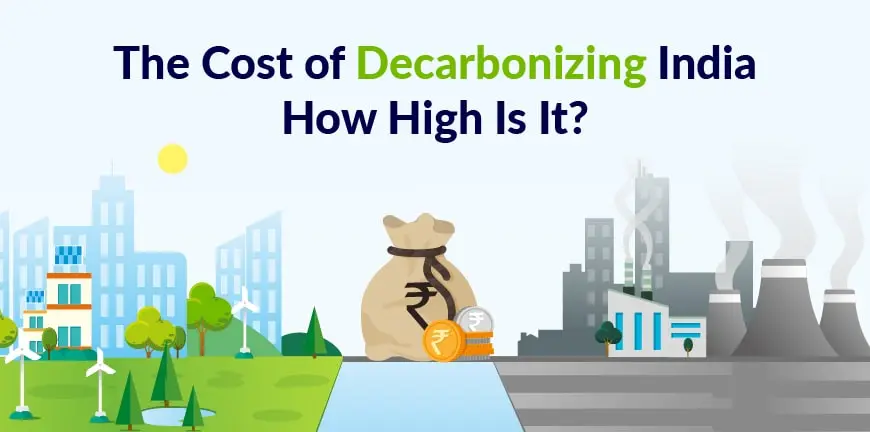
Top 8 HR Trends to Watch in 2025
24/10/2024
Payroll Cycle: Definition, Types and Factors to Consider
29/10/2024Woodburning has contributed to carbon emissions for generations since the dawn of civilization. Today, however, the carbon footprint is increasing at an unprecedented rate and is probably even unaccounted for. The good news? Countries are taking an active interest in reducing their carbon footprint and India must too.
There are many ways to manage carbon emissions. One can use carbon capture systems to reduce carbon emissions, store and then reuse the carbon in other ways. This may be the best way to control carbon emissions, along with carbon accounting, use of alternative fuel sources and raw materials and improving energy efficiency.
The Main Carbon Emissions
There are different types of emissions in each industry. But the six gases clarified by the Kyoto Protocol, which contribute to carbon emissions are:
- Carbon Dioxide, CO2
- Methane, CH4
- Nitrous Oxide, N2O
- Hydrofluorocarbons, HFCs
- Perfluorocarbons, PFCs
- Sulphur Hexafluoride, SF6
The two main tactics to reduce carbon emissions, that industries must rely on, apart from carbon capture, are carbon accounting and consequent efforts to improve energy efficiency in processes.
Carbon Accounting
Carbon Accounting is the process of tracking the amount of carbon emissions that an organization or business generates. In each industry it is important to track both direct and indirect emissions. In India, there needs to be more robust forms of monitoring the emissions at each stage and more transparency in the reporting of data. More incentives must be provided to each industry not just to regulate carbon emissions but to account for these emissions periodically in India.
Energy Efficiency
Energy can be used more efficiently to reduce emissions and lower energy costs. In each industry, it is necessary to inspect the processes and track the areas where the emissions are more. Heat and energy recovery are possible in many industries as is the use of advanced technology to become more energy efficient. Looking at data with the help of AI and drawing inferences can help to also make the processes more energy efficient globally.
Now, let us look at how we can decarbonize the main sectors in India and the cost of decarbonizing every industry.
How to and Cost of Decarbonizing the Sectors in India?
Oil and Gas
Direct emissions happen during the oil and gas processes and indirect are those that happen during the process of procurement, during the preparation of hydrogen (which is used by petroleum refineries) and by third parties associated with a company.
Carbon accounting must happen at each stage of the oil and gas process, with a focus on the processes where the emissions are maximum. Eliminating methane leaks and flaring and the use of low-emitting engines in the production process can help with reducing carbon emissions.
In oil and gas, the traditional and effective methods to improve energy efficiency are upgrading the technology used for petroleum extraction and refinement and by optimizing the location of wells and improving the productivity of existing wells.
The cost of decarbonizing the oil and gas sector in India is very high, with several companies investing billions of rupees in initiatives. The ONGC aims to invest 2 trillion rupees by 2038 to achieve net-zero carbon emissions. Oil India plans to achieve net-zero emissions by 2040 with an investment of 25,000 crore rupees.
Steel
If we account for the methane emissions emerging from coal mining, primarily used to manufacture steel, the carbon footprint goes up to 27%. Minimizing coal usage, if possible, could help reduce emissions. Also, most steel is hot rolled. And there are emissions that happen at this stage. It is necessary to benchmark the emissions at this stage for greater accuracy in carbon accounting. Improving furnace design, using oxygen enrichment, and incorporating variable speed drives in motors can all improve energy efficiency in steel processes.
The total capital investment required to decarbonize the steel industry is estimated to be about 21.2 lakh crore rupees. The operating expenditure is estimated to be about 66.7 thousand crores annually. If the carbon capture and storage methods are implemented, then steel is expected to be 40-70% more costly. This is not a favorable scenario in a world where there is already an oversupply of steel. Unless the world incentivizes low-carbon footprint steel production, the situation cannot easily improve.
Cement
India is growing at a rapid rate and the demand for cement generated by infrastructure projects like low-cost housing, and the push for SMART Cities is also growing. While it is necessary to keep up with accelerated demand, it is also necessary to do carbon accounting at each stage of the cement manufacture process.
In the cement industry, it is important to account for two main sources of carbon emissions, the conversion of calcium carbonate to lime, the main component in steel and the combustion of fuels such as coal, which we now see as a recurring theme in contributing to carbon emissions in India.
A preheater in the cement industry heats the raw materials before they are fed into the kiln. The kiln then heats the raw materials to create cement clinker, a main component of cement. There must be measures in place to regulate the temperature and pressure both within the preheater and that of moisture when sourcing the coal. Moving to more advanced preheaters also helps increase energy efficiency.
As a nod to the efforts put by the Government of India and other parties, India’s cement industry, much like its steel industry is one of the most efficient in the world. The cost to decarbonize the cement industry in India requires about 334 billion USD in capital expenses and 3 billion USD in operating expenses annually. By using renewable energy, other raw materials and alternative fuels, cement emissions can be reduced by 13%. But it is carbon capture utilization and storage that will play a bigger role in reducing cement carbon emissions.
Automobile
The task of carbon accounting for the automotive industry is very complicated, as it depends on other industries such as steel and OEMs are involved in the production of automobiles for the main car brands. The automotive industry, not just in India but worldwide, needs to spend more on data collection and reporting technologies and incorporate the use of AI to improve carbon accounting in addition to the steps mentioned earlier for all industries.
It is necessary to commit to energy efficiency during the process of automobile manufacturing, such as by using efficient lighting and ventilation systems and reducing the need for energy supply in areas where it can be minimized. Moving to more advanced technology that consumes less power is also important.
Leapfrogging from BS-IV to BS-VI norms for vehicles helped address the issue of improving the particulate filters in diesel vehicles. The National Program on Advanced Chemistry Cell Battery Storage recently allocated 18,100 crore rupees towards building better batteries for EVs, and consequently minimize emissions. Tata Motors showcased their Hydrogen powered truck at the Auto Expo 2023, which is part of their long-term commitment to net zero emissions. Decarbonizing automobile industry requires innovative and monetary efforts from both private parties as well as the government and therefore, a cost is difficult to establish.
Aerospace
Most emissions in the Aerospace industry are direct emissions, and are based on the combustion of jet fuel, 99% of which is CO2. Fuel consumption data is usually shared between the flight operators, fuel procurement companies and financial planning and analysis teams and is useful for carbon accounting. The upstream factor which contributes heavily to carbon emissions is in the extraction and preparation of the jet fuel used in the aircraft. This too must be monitored.
To maintain energy efficiency in the aerospace industry, the companies can move to advanced propulsion systems and rely on alternative fuel, that may be more energy efficient. They can also move to more energy efficient lighting and air conditioning wherever it is used. They can also recover energy during the process of braking and reuse the energy, which requires the use of better technology.
Again, we have no data for how costly decarbonization of aerospace industry in India would be. Most aircraft are manufactured by Boeing and Airbus, both privately held and there would need to be a collaboration between them and India to achieve net-zero emissions. Sustainable aviation fuels are a way forward and can reduce carbon emissions by at least 70%, in comparison with fossil fuels.
Closing Words
India is well on its way to achieving its net-zero target through renewable energy sources, controlling carbon emissions and with advanced technology for data capture and monitoring, but when will this be achieved? We can look at a tentative date of 2050. According to a McKinsey report, the total cost of decarbonizing India is about USD 7.2 trillion in green investments. But will this be possible, given the immediate and growing needs of India as a developing country marching its way towards progress? And will the industries be profitable enough to drive a growing economy? This is something to ponder upon.
Contact Us For Business Enquiry

Rajkumar Shanmugam
Rajkumar Shanmugam is the Head of HR at ALP Consulting, bringing over 19 years of comprehensive HR leadership experience across India and international markets. His expertise spans talent acquisition, employee relations, performance management, compliance, and HR transformation. Rajkumar has a proven track record of driving people-centric initiatives, enhancing workplace culture, and aligning HR strategy with business goals. With extensive experience in US staffing operations and global mobility, he continues to lead organizational excellence through innovation and employee engagement.




